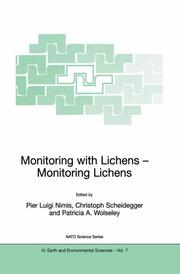Detailansicht
Monitoring with Lichens - Monitoring Lichens
Nato Science Series: IV: Earth and Environmental Sciences, Volume 7, NATO Science Series: IV: 7
ISBN/EAN: 9781402004308
Umbreit-Nr.: 1565659
Sprache:
Englisch
Umfang: ix, 408 S.
Format in cm:
Einband:
kartoniertes Buch
Erschienen am 31.01.2002
- Zusatztext
- A comprehensive, up-to-date review of lichens as biomonitors of air pollution (bioindication, metal and radionuclide accumulation, biomarkers), and as monitors of environmental change (including global climate change and biodiversity loss) in a wide array of terrestrial habitats. Several methods for using lichens as biomonitors are described in a special section of the book.
- Kurztext
- Proceedings of the NATO Advanced Research Workshop on Lichen Monitoring, Wales, United Kingdom, 16-23 August 2000
- Autorenportrait
- Inhaltsangabe1. Monitoring with Lichens - Monitoring Lichens; An Introduction; P.L. Nimis, et al. Section 1: Monitoring Lichens as Indicators of Pollution. 2. Monitoring Lichens as Indicators of Pollution; An Introduction; P.L. Nimis, O.W. Purvis. 3. Bioindication: Calibrated Scales and their Utility; D.L. Hawksworth. 4. Bioindication: The I.A.P. Approach; R. Kricke, S. Loppi. 5. Bioindication: The Community Approach; C. van Haluwyn, K.C.M. van Herk. 6. Accumulation of Inorganic Contaminants; R. Bargagli, I. Mikhailova. 7. Lichens as Monitors of Radioelements; M.R.D. Seaward. 8. Biomarkers of Pollution-Induced Oxidative Stress and Membrane Damage in Lichens; D. Cuny, et al. 9. Key Issues in Designing Biomonitoring Programmes; Monitoring scenarios, sampling strategies and quality assurance; M. Ferretti, W. Erhardt. Section 2: Monitoring Lichen Diversity and Ecosystem Function. 10. Monitoring Lichen Diversity and Ecosystem Function; An Introduction; S. Will-Wolf, C. Scheidegger. 11. Methods for Monitoring Biodiversity and Ecosystem Function; Monitoring scenarios, sampling strategies and data quality; S. Will-Wolf, et al. 12. Monitoring Lichens for Conservation: Red Lists and Conservation Action Plans; C. Scheidegger, T. Goward. 13. Lichen Monitoring and Climate Change; G. Insarov, B. Schroeter. 14. Monitoring Biodiversity and Ecosystem Function: Forests; S. Will-Wolf, et al. 15. Monitoring Biodiversity and Ecosystem Function: Grasslands, Deserts, and Steppe; R. Rosentreter, D.J. Eldridge.16. Monitoring Lichens on Monuments; A. Aptroot, P.W. James. 17. Monitoring Maritime Habitats; A. Fletcher, R. Crump. Section 3: Methods for Monitoring Lichens. 18. Methods for Monitoring Lichens; An Introduction; P.A. Wolseley, D.J. Hill. 19. Mapping Lichen Diversity as an Indicator of Environmental Quality; J. Asta, et al. 20. Identifying Deviations from Naturality of Lichen Diversity for Bioindication Purposes; S. Loppi, et al. 21. Epiphytes on Wayside Trees as an Indicator of Eutrophication in the Netherlands; K.C.M. van Herk. 22. Using Lichens on Twigs to Assess Changes in Ambient Atmospheric Conditions; P.A. Wolseley. 23. Guidelines for the Use of Epiphytic Lichens as Biomonitors of Atmospheric Deposition of Trace Elements; R. Bargagli, P.L. Nimis. 24. Transplanted Lichens for Bioaccumulation Studies; I. Mikhailova. 25. Sample Preparation of Lichens for Elemental Analysis; A.M. Rusu. 26. Sulphur Isotopes in Lichens as Indicators of Sources; B. Spiro, et al. 27. Estimation of Critical Levels of Air Pollution (Metals) on the Basis of Field Study of Epiphytic Lichen Communities; E. Vorobeichik, I. Mikhailova. 28. Monitoring Physiological Change in Lichens: Total Chlorophyll Content and Chlorophyll Degradation; K. Boonpragob. 29. Chlorophyll Fluorescence Measurements in the Field: Assessment of the Vitality of Large Numbers of Lichen Thalli; M. Jensen, R. Kricke. 30. Measuring Bark pH; R. Kricke. 31. A Photographic Quadrat Recording Method Employing Image Analysis o
